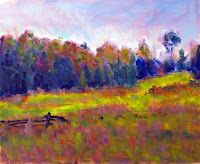Another case of "do as I say". Didn't pack recently cleaned brushes, so make do. Here I had one new #10 filbert bristle brush, and I guess my fingers. So on we go. I usually use a #12 along with say a #8. Fortunately my teacher got me into the big brush years ago. "You can make small marks with a big brush when you practice". It is true. There are many edges on a brush, so learn to use them.

August Change, 10x12, Oil on board
However, I tend to use at least one additional brush for convenience and to minimize cleaning. The big brush helps keep you away from detail - at least early in the painting process. It also facilitates a quick first stage in the painting - getting the canvas covered so you can begin to compare masses for value, hue, and intensity. I find that students tend to try to get to the end of a painting (details) before going through the beginning and middle. The big brush helps cure that problem. Then in time you find that you can "infer" detail with the big brush. The look is quite different. It focuses on shapes as opposed to things, and that helps develop the eye to "see". By this I mean you discover pieces of colour and then realize that colour for plane changes is what creates dimension and in turn detail.
This was painted in bright sun at Scottsdale farm in 45 minutes. Quite a different scene compared to spring time. The palette was Ultramarine Blue, Viridian, Cadmium Yellow, Cadmium Yellow Deep, Alizarin, and Titanium White.
No comments:
Post a Comment